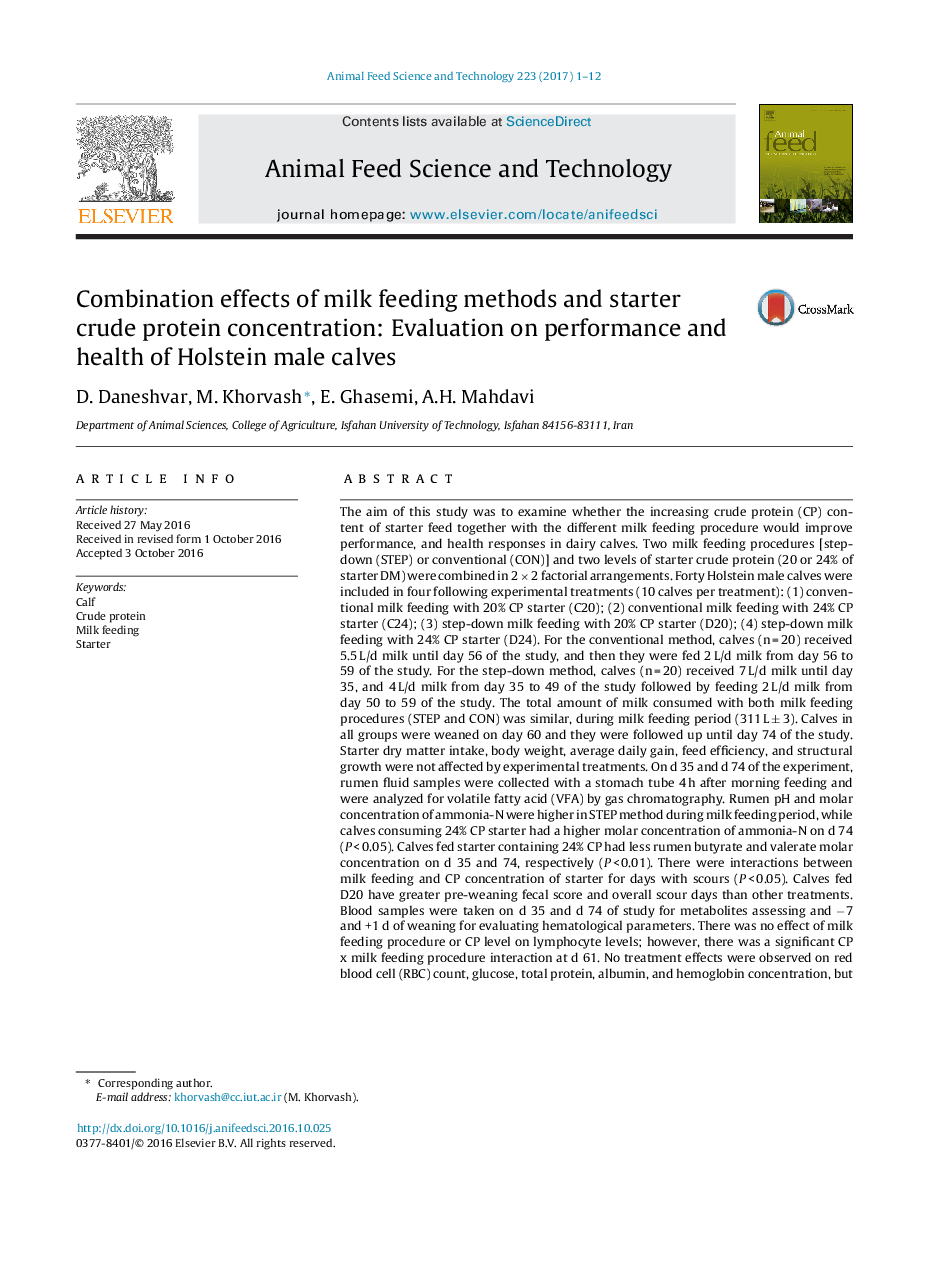| کد مقاله | کد نشریه | سال انتشار | مقاله انگلیسی | نسخه تمام متن |
|---|---|---|---|---|
| 5538864 | 1552363 | 2017 | 12 صفحه PDF | دانلود رایگان |
عنوان انگلیسی مقاله ISI
Combination effects of milk feeding methods and starter crude protein concentration: Evaluation on performance and health of Holstein male calves
ترجمه فارسی عنوان
اثرات ترکیبی روشهای تغذیه شیر و غلظت پروتئین خام اولیه: ارزیابی عملکرد و سلامت گوسالههای هولشتاین
دانلود مقاله + سفارش ترجمه
دانلود مقاله ISI انگلیسی
رایگان برای ایرانیان
کلمات کلیدی
گوساله، پروتئین خام تغذیه شیر، شروع کننده،
موضوعات مرتبط
علوم زیستی و بیوفناوری
علوم کشاورزی و بیولوژیک
علوم دامی و جانورشناسی
چکیده انگلیسی
The aim of this study was to examine whether the increasing crude protein (CP) content of starter feed together with the different milk feeding procedure would improve performance, and health responses in dairy calves. Two milk feeding procedures [step-down (STEP) or conventional (CON)] and two levels of starter crude protein (20 or 24% of starter DM) were combined in 2 Ã 2 factorial arrangements. Forty Holstein male calves were included in four following experimental treatments (10 calves per treatment): (1) conventional milk feeding with 20% CP starter (C20); (2) conventional milk feeding with 24% CP starter (C24); (3) step-down milk feeding with 20% CP starter (D20); (4) step-down milk feeding with 24% CP starter (D24). For the conventional method, calves (n = 20) received 5.5 L/d milk until day 56 of the study, and then they were fed 2 L/d milk from day 56 to 59 of the study. For the step-down method, calves (n = 20) received 7 L/d milk until day 35, and 4 L/d milk from day 35 to 49 of the study followed by feeding 2 L/d milk from day 50 to 59 of the study. The total amount of milk consumed with both milk feeding procedures (STEP and CON) was similar, during milk feeding period (311 L ± 3). Calves in all groups were weaned on day 60 and they were followed up until day 74 of the study. Starter dry matter intake, body weight, average daily gain, feed efficiency, and structural growth were not affected by experimental treatments. On d 35 and d 74 of the experiment, rumen fluid samples were collected with a stomach tube 4 h after morning feeding and were analyzed for volatile fatty acid (VFA) by gas chromatography. Rumen pH and molar concentration of ammonia-N were higher in STEP method during milk feeding period, while calves consuming 24% CP starter had a higher molar concentration of ammonia-N on d 74 (P < 0.05). Calves fed starter containing 24% CP had less rumen butyrate and valerate molar concentration on d 35 and 74, respectively (P < 0.01). There were interactions between milk feeding and CP concentration of starter for days with scours (P < 0.05). Calves fed D20 have greater pre-weaning fecal score and overall scour days than other treatments. Blood samples were taken on d 35 and d 74 of study for metabolites assessing and â7 and +1 d of weaning for evaluating hematological parameters. There was no effect of milk feeding procedure or CP level on lymphocyte levels; however, there was a significant CP x milk feeding procedure interaction at d 61. No treatment effects were observed on red blood cell (RBC) count, glucose, total protein, albumin, and hemoglobin concentration, but highest values of blood urea nitrogen (BUN) were found with the 24% CP starter diets on d 74 (P < 0.05). In conclusion, increasing starter CP concentration in both milk feeding procedures had no effects on calf performance, structural growth or health.
ناشر
Database: Elsevier - ScienceDirect (ساینس دایرکت)
Journal: Animal Feed Science and Technology - Volume 223, January 2017, Pages 1-12
Journal: Animal Feed Science and Technology - Volume 223, January 2017, Pages 1-12
نویسندگان
D. Daneshvar, M. Khorvash, E. Ghasemi, A.H. Mahdavi,
